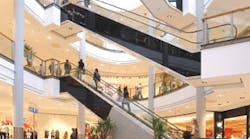Retail security is far more complex than just deterring teenagers from shoplifting. Data security, loss prevention, organized crime, fraud, workplace violence, and terrorism make securing a retail property a full-scale operation that leaves many businesses puzzled as how to tackle it all.
When it comes to alarm systems in retail facilities, they can help you address many of these issues.
Retail Loss and Employees
Inventory shrink cost businesses $33.5 billion in 2009. "Everything we do revolves around this number," says Rhett Asher, vice president of loss prevention for the National Retail Federation (NRF).
Some companies may be surprised to find that employees are responsible for the majority of theft. They comprise 43 percent of shrinkage, while shoplifting is only responsible for 35 percent. Acknowledging that your employees need to be monitored allows you to develop your security practices to their fullest extent. One point to keep in mind: Keep the number of building occupants who know how the alarm systems work to a minimum. If too many occupants know about the alarm systems and how to disarm them, security measures may be thwarted internally.
Areas such as breakrooms, hallways, offices, and backrooms are often neglected in terms of alarms in retail facilities. "A lot of emphasis is given to external protection and access control to these areas, but an assumption is made that, once the doors are locked, the employees can be trusted. From a safety and a risk perspective, more attention needs to be paid to non-public areas," recommends Asher.
To address this, adding alarms to these back areas can provide alerts to activity. "Consider the installation of a bell, buzzer, or chime on all fire or exit doors to alert the manager and other employees when the door is opened. This should be in addition to any crash bar device, which can be disarmed. The sound should be audible from all key areas of the store," advises ADT, a national security services provider.
This is a simple, cost-effective solution for monitoring areas off of the general floor. "Even the most basic alarm systems can provide rear door access control without violating fire codes (locked doors) or utilizing expensive door hardware," says Bill Alford on behalf of ASIS International's Retail Loss Prevention Council.
Electronic Surveillance Systems
Electronic security systems, including alarms, aren't as effective when marketed as individual components instead of as an integrated system. Not only are many of these products used reactively to report or review a problem, but they also make your security measures "reliant upon proprietary software and hardware that drive up maintenance costs and require dependency upon a specific vendor, service, or equipment," explains Alford.
To alleviate this problem, "electronic systems can be integrated to provide optimal security and functionality for end-users while maximizing the value of capital expenditures. The CCTV system, if integrated with the alarm system, for example, can provide a high level of proactive security to review opening/closings, afterhours key holder entry and exit, and many other functions, including audits of operational and security processes, in a proactive fashion," recommends Alford.
Keep in mind, however, that system integration will be compromised if electronic alarms are infrequently engaged. As Alford points out, "alarms are installed in virtually every retail location, but are [sometimes] only armed at night for simple 'burglar alarm detection' or, in the case of 24/7 operations, these alarm systems are only turned on when the stores are closed on holidays." Evaluate your security needs and make sure your alarms are optimally activated.
Comprehensive Security
While alarms are an important part of any building's security, Barbara A. Nadel, principal of Barbara Nadel Architect, recommends a well-rounded approach to ensure that your security measures are comprehensive. "Using a combination of electronic systems and security personnel allows owners to gain greater control over what happens in and around their facilities. Additionally, good design of retail spaces, including good visibility and lighting, along with technology and sound policies and procedures for security and retail personnel, will enhance overall safety and security."
Jennie Morton ([email protected]) is assistant editor for BUILDINGS.


